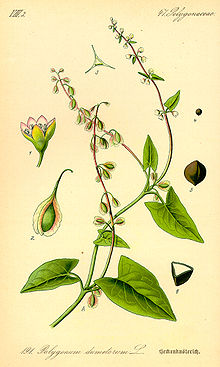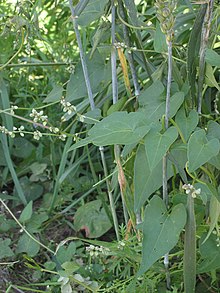Knot oak
| Knot oak | ||||||||||||
|---|---|---|---|---|---|---|---|---|---|---|---|---|

Japanese knotweed ( Fallopia japonica ) |
||||||||||||
| Systematics | ||||||||||||
|
||||||||||||
| Scientific name | ||||||||||||
| Fallopia | ||||||||||||
| Adans. |
The winged knotweed ( Fallopia ) are a genus of plants within the knotweed family (Polygonaceae). The 7 to 18 species are widespread in the temperate to subtropical zones of the northern hemisphere .
description


Appearance and leaves
The fallopia species are deciduous, right- winding annual to perennial herbaceous plants or creeping trees . The roots are fibrous to woody. Some species form rhizomes . The seldom prostrate, mostly independently upright or twisting shoot axes are hairy or hairy and in some species can become lignified at their base. Some species are relatively fast-growing.
Their alternately arranged leaves are divided into a petiole and a leaf blade. The leaf stalks have a joint at their base and, in some species, extra-floral nectaries . The simple leaf blades are broadly ovate to triangular, with a smooth or wavy leaf margin and often with a heart- or arrow-shaped base. The durable or ephemeral, tubular Ochrea has a sloping or truncated upper end.
Inflorescences and flowers
There may be inflorescence stems. Terminal and / or lateral, racemose or paniculate total inflorescences are formed, each of which contains a bundled partial inflorescence with one to five flowers over an ochrea.
The shape of the stalked, hermaphrodite or unisexual flowers is characteristic . There are specimens with hermaphrodite flowers and some with only female flowers. Of the five bracts, the outer three are larger, keeled or, in most species, strongly winged, rarely not keeled and wingless; this feature also earned this genus the name wing knotweed. The inner two bracts are smaller and inconspicuous. The mostly white, greenish-white to pink-colored, mostly bald bracts grow in size until they are ripe. The bracts are fused to almost completely bell-shaped only at their base. There are six to eight free stamens . The stamens are glabrous or hairy in the lower area. The yellow or pink to red anthers are ovate to elliptical. Three carpels are a single-chamber ovary grown. The three distally spreading, very short stylus branches that are only at their base or almost completely overgrown, end in heady, frayed or shield-shaped scars.
Fruits and seeds
The fruit ( achenes ), which are brown to dark brown or almost black when ripe, is egg-shaped and triangular, but not winged. It is partially or completely surrounded by the flower envelope. The seeds contain a straight embryo .
Chromosome numbers
The basic chromosome number is x = 10 or 11.
Occurrence
The genus Fallopia is distributed in large parts of the northern hemisphere in the temperate to subtropical zones. There are about eight species in North America, but only Fallopia cilinodis and Fallopia scandens are native to them. There are about eight species in China, three of which are only there.
Many species like to grow in locations where the natural vegetation is disturbed, for example on fields, ruderal sites, rubble sites or on river banks influenced by humans.
The common knotweed or field knotweed ( Fallopia convolvulus ), which is native to large parts of Eurasia , is considered a field weed . Some species, such as the Japanese knotweed, are considered problematic invasive neophytes where they were introduced .




Systematics
The genus Fallopia was established in 1763 by Michel Adanson in Familles des Plantes , 2, pages 274, 277, 557. The type species is Fallopia scandens (L.) Holub . Synonyms for Fallopia Adans. are Bilderdykia Dumort. and Pleuropterus Turcz. The genus Fallopia belongs to the tribe Polygoneae in the subfamily Polygonoideae within the family of Polygonaceae . The generic name Fallopia honors the Italian anatomist and surgeon Gabriele Falloppio (1523–1563).
The species of the genus Fallopia were previously incorporated into Polygonum , which is why all species have a synonym in this genus.
There are 7 to 17 Fallopia species (the number of species depends on whether Reynoutria is included):
- Schlingknöterich ( Fallopia baldschuanica (Regel) Holub , Syn .: Polygonum baldschuanicum Regel , Fallopia aubertii (L.Henry) Holub , Polygonum aubertii L.Henry ): It is native to Central Asia . In Europe and North America it is a neophyte .
- Fallopia cilinodis (Michx.) Holub , Syn .: Polygonum cilinode Michaux , Bilderdykia cilinodis (Michx.) Greene , Bilderdykia cilinodis var. Laevigata (Fernald) CFReed , Polygonum cilinode var. Laevigatum Fernald , Reynoutria cilinodis (Michx.) Shinners , Tiniaria cilinodis (Michaux) Small : It iswidespreadin North America and thrives at altitudes between 0 and 900 meters.
- Bindweed knotweed ( Fallopia convolvulus (L.) Á.Löve , syn .: Polygonum convolvulus L. , Bilderdykia convolvulus (L.) Dumort. , Fallopia convolvulus var. Subalata (Lejeune & Courtois) DHKent , Reynoutria convolvulus (L.) Shinners , Tiniaria convolvulus (L.) Webb & Moquin-Tandon ex Webb & Berthelot ): It is native to Eurasia and North Africa. It is a neophyte in much of the world. It is rated as an aggressive field weed.
-
Fallopia cynanchoides (Hemsl.) Haraldson , Syn.Polygonum cynanchoides Hemsl. : It occurs in western China and thrives there in forests in valleys and on mountain slopes as well as on the edge of the forest at altitudes between 1100 and 3000 meters. With two varieties:
- Fallopia cynanchoides (Hemsl.) Haraldson var. Cynanchoides
- Fallopia cynanchoides var. Glabriuscula (AJLi) AJLi
- Fallopia dentatoalata (F.Schmidt) Holub (Syn .: Polygonum dentatoalatum F. Schmidt ): It is native to China, Korea, Russia's Far East and Japan. In China it is widespread and thrives there in mixed forests in valleys and on slopes at altitudes between 200 and 2800 meters.
- Fallopia denticulata (CCHuang) Holub (Syn .: Polygonum denticulatum C.C. Huang ): It occurs only in southern China: perhaps in Guizhou and Xizang, only in Yunnan (Gengma), where it thrives in bushes in valleys at altitudes of around 2500 Meter.
- Hedge bindweed ( Fallopia dumetorum (L.) Holub ; Syn .: Polygonum dumetorum L. , Bilderdykia scandens (L.) Greene var. Dumetorum (L.) Dumort. , Polygonum scandens L. var. Dumetorum (L.) Gleason , Reynoutria scandens (L.) Shinners var. Dumetorum (L.) Shinners , Tiniaria dumetorum (L.) Opiz ): It is native to Eurasia and North Africa. It is a neophyte, especially in North America.
- Fallopia filipes (Hara) Holub : It thrives in Nepal at altitudes between 1900 and 2900 meters.
- Fallopia forbesii (Hance) Yonek. & H.Ohashi (Syn .: Polygonum forbesii Hance ): It isnative tonorthern China and Korea .
- Japanese knotweed ( Fallopia japonica (Houtt.) Ronse Decr. , Syn .: Fallopia japonica f. Colorans (Makino) Yonek. , Fallopia japonica var. Compacta (Hook. F.) JPBailey , Fallopia japonica var. Compacta J.Bailey , Fallopia japonica var. hachidyoensis (Makino) Yonek. & H.Ohashi , Fallopia japonica var. uzenensis (Honda) Yonek. & H.Ohashi , Pleuropterus cuspidatus (Siebold & Zucc.) H. Gross , Polygonum cuspidatum Siebold & Zucc. , Polygonum reynoutria Makino , Reynoutria henryi Nakai , Reynoutria japonica Houtt. , Tiniaria japonica (Houtt.) Hedberg ): It is native to East Asia. It is used as an ornamental plant. She is in many parts of the world she is a neophyte.
- Fallopia koreana B.U.Oh & JGKim : It is native to Korea .
-
Fallopia multiflora (Thunb.) Haraldson (Syn. Polygonum multiflorum Thunb. ): It is widespread in Japan, Taiwan and China. In China it thrives on mountain slopes, in crevices and in bushes in valleys at altitudes between 200 and 3000 meters. With two varieties:
- Fallopia multiflora (Thunb.) Haraldson var. Multiflora
- Fallopia multiflora var. Ciliinervis (Nakai) Yonek. & H.Ohashi
- Fallopia pterocarpa (Wall. Ex Meisn.) Holub Syn .: Polygonum pterocarpum Wall. ex Meisn. : It thrives in the Himalayas at altitudes between 1500 and 2200 meters.
- Sakhalin knotweed ( Fallopia sachalinensis (F.Schmidt) Ronse Decr. , Syn .: Polygonum sachalinense F.Schmidt , Reynoutria sachalinensis (F.Schmidt) Nakai ): It is native from Eastern Siberia to Japan. It is a neophyte in many parts of the world.
- Fallopia scandens (L.) Holub (Syn .: Polygonum scandens L. , Fallopia cristata (Engelm. Ex A. Gray) Holub ): It is widespread in North America and thrives at altitudes between 0 and 1800 meters.
- Fallopia schischkinii Tzvelev : It is native to Russia.
There are around three natural hybrids :
- Fallopia × bohemica (Chrtek & Chrtková) JPBailey (Syn .: Polygonum × bohemicum (Chrtek & Chrtková) Zika & Jacobson , Reynoutria × bohemica Chrtek & Chrtková ): It is native to Europe and is a neophyte especially in North America.
- Fallopia × conollyana J.P.Bailey : This is a cross of Fallopia baldschuanica × Fallopia japonica .
- Fallopia × convolvuloides (Bruges) Holub
swell
- Craig C. Freeman & Harold R. Hinds: Fallopia - text same online as printed work , In: Flora of North America Editorial Committee (Ed.): Flora of North America North of Mexico , Volume 5 - Magnoliophyta: Caryophyllidae, part 2 , Oxford University Press, New York and Oxford, 2005. ISBN 0-19-522211-3 (Description and Common Name Sections)
- Li Anjen (李安仁) & Chong-wook Park: Fallopia , pp. 315-317 - online with the same text as the printed work , In: Wu Zhengyi, Peter H. Raven, Deyuan Hong (eds.): Flora of China , Volume 5 - Ulmaceae through Basellaceae , Science Press and Missouri Botanical Garden Press, Beijing and St. Louis, 2003. ISBN 1-930723-27-X (Description and Occurrence Sections)
- Mohammad Qaiser: Polygonaceae in the Flora of Pakistan , Volume 205, University of Karachi, Department of Botany, Missouri Botanical Press, Karachi and St. Louis, 2001: Fallopia at Tropicos.org. of the Missouri Botanical Garden. (Section description)
Individual evidence
- ↑ First publication scanned at biodiversitylibrary.org .
- ^ Fallopia at Tropicos.org. Missouri Botanical Garden, St. Louis
- ^ Fallopia in the Germplasm Resources Information Network (GRIN), USDA , ARS , National Genetic Resources Program. National Germplasm Resources Laboratory, Beltsville, Maryland.


